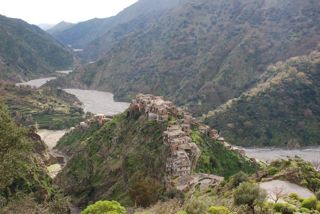- The fact is that there were over 150 monasteries, which followed the Greek Orthodox Typikon in Calabria in the 13th century. Over time, however, the Greek monastic communities, both in Calabria and Sicily, started to gradually decline. The majority of them did not even know Greek; few were able to read the Greek Orthodox Typikon (a book that sets the order of ritual during all days and holidays). Crucial for its formal abolition was the Council of Trent (1549), which imposed the Latin liturgy on the entire Catholic Church. The bishopric of Bova demonstrated the strongest resistance. There, Orthodox worship was abolished in 1573. The decision was taken by the last Orthodox bishop Ioulios Stavrianos who was of Cypriot origin. Following a secret agreement with the Archbishop of Reggio and the notables of Bova he urged the authorities and the people to attend a convivial liturgy. It was celebrated entirely in Latin on 20 January 1573, the day of St. Sebastian, whose memory was honoured by both the Latins and the Greek Orthodox Church. It is distinguished for the fact that the believers reprimanded the priest who celebrated the liturgy with such bitterness that he was assigned the nickname Judas. In 1579, Pope Gregory XIII organized the Greek monks in southern Italy in an order, which on the one hand saved the Greek monasteries from total decline, but made them more dependent on the papal church, which led to their rapid latinisation. The influence of the Catholic Church, the gradual retreat of the Greek language under the pressure of Latin and the illiteracy of the Greek clergy led to a lasting decline in Orthodoxy, especially during, and at the end of, the 16th century. There were attempts to restore Orthodox worship during the 1970s on the initiative of the Greek and Italian associations that fought to preserve the Greek language in Calabria. A small Orthodox church was built in Galiciano around 1992, dedicated to the Virgin of Greeks (Παναγία των Ελλήνων). Its foundation was dictated more by the strong tendency to "Grecisation" of the area and turning it into a tourist destination, rather than by the religious needs of the local population.
- The ban on the Orthodox rite, the more frequent contacts with the Italian population, military conscription, the breakup of strict endogamy, education, the impact of media and the acute sense of inferiority that had been propagated for years in the Greek-speaking population led to a gradual decline of the language and customs. Prejudices and negative stereotypes, anyway, were valid not only for the Greek-speaking people but also for all Calabrians (and all southerners). Which villages still spoke the Greek language at the time of your research and how have things changed as of today? For example, Galiciano, where the Greek language had been preserved in its most lively form, was the most isolated and poor village in the entire region.
- In 1983, when I visited this area for the first time, all spoke "Greco" (γκρέκο, which is how the locals call their language) in the villages of Galiciano and Rogoudi. I will never forget the first day when I woke up in the village and heard two women talking loudly to each other outside, at my door, saying these striking words, "put his hand on her" ("της έβαλε χέρι"), mentioning some man who was bothering a girl. This expression is literally used in all parts of Greece. In those years, Greek-speaking people lived in Bova Superiore and in the coastal village of Bova Marina. We are talking about people who originated in the village of Rogoudi. A prominent figure among them was Angelo Maesano (Rogoudi, 1915- Bova, 2000), known as Mastr 'Angelo, a profound expert of the Greek language. While I carried out my study, he wrote one of the best songs in Calabrian Greek - "Come, come to me" («Έλα, έλα μου κοντά»). I was fortunate to be present during the entire composing process of this wonderful song. Our meetings took place at the house of another eminent figure in the Greek-speaking community - Elisabetta Nucera, who had fought for the official recognition of the "γκρέκο" language.
The main factors contributing towards the preservation of the language for so many centuries were the geographical isolation of the area, difficult communication with the outside Italian-speaking world, the closed agricultural and stockbreeding economy and illiteracy. Conversely, more frequent contacts with the Italian-speaking population, natural disasters (floods and landslides) and subsequent displacements of populations from the mountains to the plains, as well as general changes (social, economic and cultural) after the 1960s have contributed towards the gradual retreat of the "γκρέκο" language. Today the majority of the people have moved to coastal centres, mainly in Kondofouri Marina.
The cooperation with Sotiris Christakis, my partner during the years of my anthropological expedition, and later my husband, was invaluable. I owe to him the unique photographs of local people and customs. As part of the illustrations for this interview I am submitting photos made by him in the 1980s.
- One of these villages, namely Rihoudi, is considered as an architectural masterpiece and it is  present as an example for readers in manuals and textbooks on town planning. What distinguishes this village?
present as an example for readers in manuals and textbooks on town planning. What distinguishes this village?